Back On The Road With Rush
"Clockwork Angels" Tour Steams Across Continents
By Andrew King, Professional Lighting And Production, Summer 2013, transcribed by pwrwindows
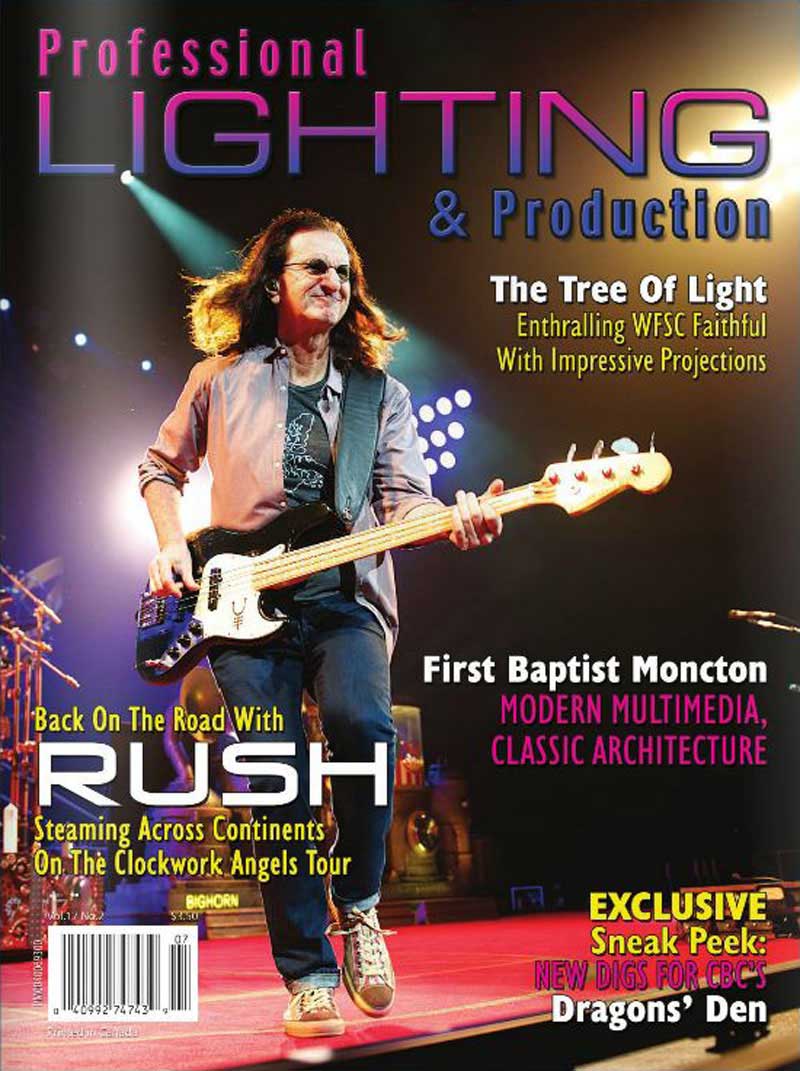
When prog-rock iconoclasts Rush embarked on their year-long Time Machine Tour in June 2010, they introduced audiences on three continents to an elaborate steampunk-themed set that beautifully embodied the elements of sci-fi and fantasy that have long been laced into their output.
Throughout that trek, fans were treated to two new songs - "Caravan" and "BU28 (Brought Up To Believe)" - from the then-upcoming album Clockwork Angels, the group's 19'" studio album, which saw its official release in June 2012.
Just over a year after the Time Machine Tour wrapped, Rush was back on the road with the Clockwork Angels Tour - in many ways an extension of its predecessor that kept the steam punk motif and locus on elaborate automation and lavish visuals while employing a number of new and exciting elements to help tell the story behind the album from the stage.
"Sitting down with Geddy [Lee, Rush bassist and vocalist] when the Time Machine Tour first started, he shared the steampunk idea and how [Clockwork Angels], lyrically, would fit that," begins Howard Ungerleider of Production Design International about early plans for the tour that preceded the Clockwork Angels trek, Ungerleider has been the band's go-to lighting designer and operator for nearly four decades and, subsequently, has Significant influence on the design and execution of Rush's stage show.
The narrative behind Clockwork Angels is loaded with the mind-stretching philosophy and fantasy for which the band is well known. It tells the story of a young man who steps out into the world and, through numerous experiences and encounters, eventually comes to realize that he is the ultimate architect of his future.
Ideas for the set and visual design were conceived during early brainstorming sessions with Ungerleider, Lee, film producer Allan Weinrib, and film director Dale Heslip. The latter pair then relayed their concepts and storyboards to a number of content creation firms. "We had to come up with something unique and different than we had on the last tour," Ungerleider says. "We kept the steampunk idea, but took it to a new place."
That place ended lip being a representation of the fictional city where the Clockwork Angels story is set. To boost the sense of intrigue and wonder surrounding the album and story behind it, the creative team behind the tour's visual components placed a strong emphasis on motion - avant-garde shapes and designs moving quickly and slowly with a split between a surreal, sci-fi aesthetic at times and a clean, stark, and Spartan one at others.
"This design is very unique because of all of the moving parts and how I use them," the LD shares. "We always want to complement what the band does. This isn't an overwhelming statement; our design was done to work in tandem with the music and lyrics."
For Ungerleider and IMAG video director David Davidian, the Clockwork Angels Tour is essentially a hybrid of cutting-edge technology with old-school technique. Despite its use of some of the newest products and platforms on the market. this tour is what Ungerleider calls "very manual." He elaborates: "I have a computer system that runs the lighting console, so I trigger the cues manually but use computers for the matrixing."
At FOH, Ungerleider is running three Full Boar 4 consoles from High End Systems, each with an expansion wing on which he operates the show. On the video side, he's using three Catalyst media servers - his go-to for its reference of frames-per-second. "For me to chase audio in perfect time based on frames per second and time code, where the band doesn't have to be linked to the time code," he explains, "I can line it all up with a musical cue, whether it be from Geddy, Alex [Lifeson, guitarist], or Neil [Peart, drummer and lyricist]."
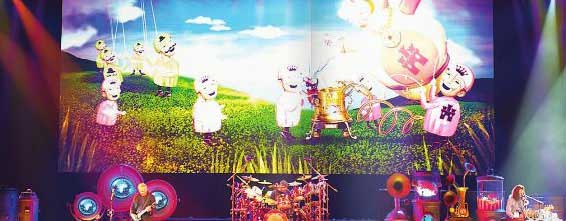
Many of those cues are triggered by the Catalyst through the lighting console while others are cued by Davidian, who calls all of the live camera shots in real time during the show. The IMAG is always running, though what the audience actually sees is an ever-changing split between the pre-recorded content and live footage.
The on-the-fly operation of both the video and lighting elements allows the experienced operators behind the boards to work with the same focus on dynamics and spur-of-the-moment brilliance for which the band they're supporting is so well known. "I have the option of creating on the fly and augmenting cues running through the computer system as well," Ungerleider offers. "It's basically a mood thing -you're following the now of what's happening."
It makes for an interesting contrast that the Clockwork Angels Tour, when it comes to creative personnel, carries an attitude of "sticking with what works," yet on the other hand, Ungerleider reveals that approximately 90 percent of his rig is comprised of fixtures he'd never used prior to this tour and its predecessor; only the HES Showguns and Vari-Lite VL3500 Profiles have previously occupied a spot in his arsenal.
Key components of the rig include the HES Intellaspot as the go-to hard edge, the Robe ROBIN 600 LED as the primary wash fixture, Clay Paky's Sharpy, and an assortment of Color Force 48 LED strip lights from Chroma-Q.
Also noteworthy are the 10 spotlight operators working on each show. Six in the onstage wings and four at FOH, filling the role of key lighting due to the absence of a front truss.
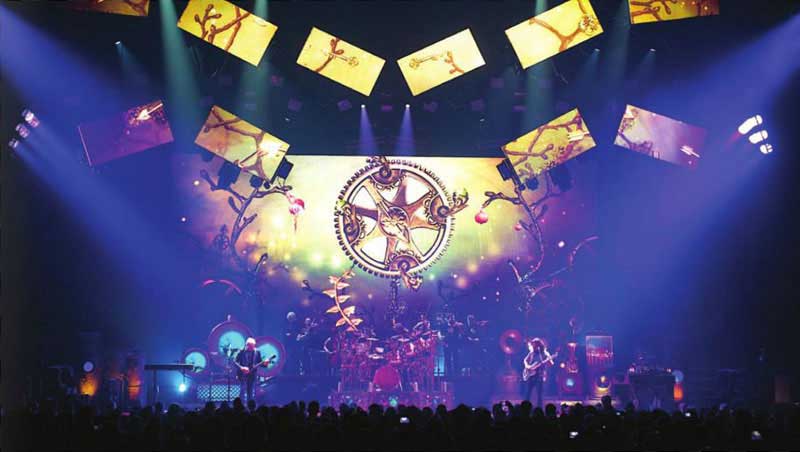
Another notable absence from the FOH area is an IMAG camera in the pit at the front of the stage. Instead, the production employs a mini camera running on a track at the downstage edge - one of five remote control led cameras loaded into the set. Another is located directly overhead of Peart's massive kit, giving the musos a much-coveted viewpoint. "They work quite well and give a very unique look to the show," Davidian says about the robotic cams and the different angles of each performer they offer.
But despite the access to the latest gadgets, Davidian, who has worked with Rush in this capacity for nearly a decade, recognizes what a camera operator brings to a production of this magnitude, "As much as I direct them," he says of his team, "it's their creativity and ability to make the shots and give me great content to blend that's invaluable. I always try to encourage a cameraman's creativity; it lets them know their work is crucial to the finished product."
Interestingly, Davidian and Ungerleider's working relationship is one that spans many years and was actually founded when the former was working as the LD for acts like Bon Jovi, Kiss, and Van Halen. Working video with his background in lighting is something both Davidian and Ungerleider see as a major asset. "He knows how lighting and video should ideally interact," Ungerleider says.
Describing his approach, Davidian shares: "I let the lighting designer do what he wants to do first, and then look at that through the cameras. I don't go in there with any pre-conceived notion of how it should look on video." Because of his background, Davidian says he "understands what the LD is doing and can feel his pain." In that sense, he adds, "It's not two different departments; I see it as the same thing."
As for Davidian's canvas, the massive 41-ft. x 17 -fl. rear video wall is comprised of Daktronics B.75 mm paneling while the moving screens out front are comprised of 12 mm Lighthouse panels. For the first time in Rush's history, there's also video incorporated into the backline via 6 mm flexible paneling, all provided by Mood Design and L.A.-based supplier Screenworks.
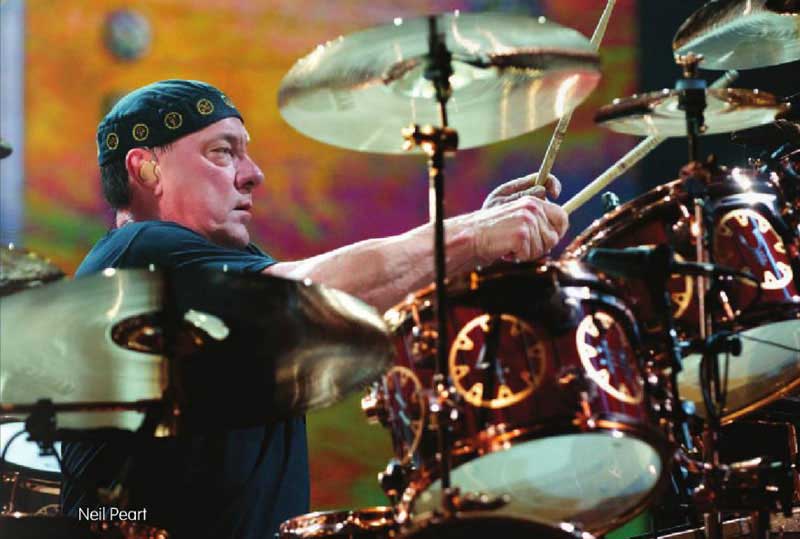
The Lighthouse product is loaded onto what Davidian and the team refer to as the "grideo" truss elements, or "eyebrow pods" - mobile pieces of winged truss designed to bring that fluid and fantasty-like motion to the set, sliding in and out of frame.
"Syncing all of the video to the music without time code is the difficult part of the show," Davidian says, but notes it's also the one that makes his job the most exciting. "We have animated windows - not just windows that sit there, but windows that will slide and actually move in and out of the frame, so you have Jive video sliding in-time with the animation and pre-shot content. It makes for some tricky programming, though that was done to perfection by Kevin Cottam, a programmer provided to us by Ross Video."
Particularly unique about his set-up for the Clockwork Angels trek is the way he's employing his Ross Video switcher to create all of the windows and effects. "A lot of times. people would use the media server for playback and to create windows, but in our case, the media server is really just a playback device and the switcher is doing all of the sizing, DVE effects, keying, and dip editing.
The idea was the brainchild of engineer Bob Larkin and needed to minimize frame delay - something that's plagued many a past production. "We've been right on the verge of delay issues ourselves," he says, "so in an effort to eliminate that, Bob, Howard, and I spoke with the design team at Ross and now have the switcher as the workhorse of the system." It's a unique way of operating, where Davidian is listening for some very intricate and fast cues to get content lined up and allow for lag time - but ultimately one that serves the show.
While it's Davidian that ultimately decides which content is sent to which screens, it's automation director Sebastien Richard that controls where those upstage screens are and when they're there. Richard heads up his own firm, SCR Automation, and in addition to working with Rush over the years has also lent his services to shows by acts like Metallica, Green Day, Celine Dion, and Pearl Jam.
While Ungerleider headed up the overall technical design, it was John Fletcher, owner of Five Points Production Services, who oversaw the execution of the staging and rigging components and Richard that handled the programming.
On the Time Machine Tour, Richard oversaw the operation of another of Ungerleider's creations, "The Spider" - a massive, custom-fabricated overhead octagonal pod truss; this time, the "grideos" are his hardware. He describes the units in detail: sections of 10-ft. truss with a hinge in the centre and suspended from three hoists, meaning they could technically be flown like a bird.
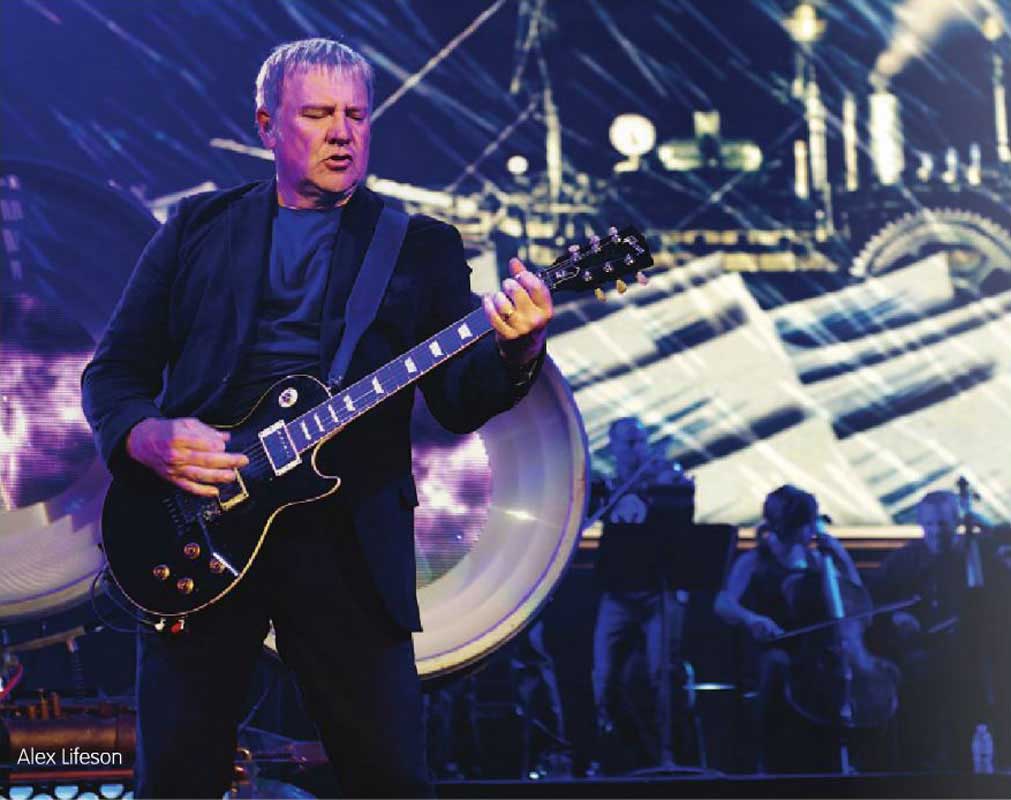
On top of this, there are 12 mini-trusses with RSC Lightlocks suspended from high-speed Show Distribution motors and loaded with the Clay Paky Sharpys for very quick - up to 104 ft. per minute - yet smooth, controlled motion. Richard operates that part of the show using Chainmaster's software platform.
Richard worked closely with Ungerleider and Weinrib at the outset of the tour to plan the various moves and looks that would be employed and ensure the lighting and video would sync in a complementary fashion.
Their major focus, as previously mentioned. was to create a look that was completely different from that used on the Time Machine Tour, despite the similar overall motif. "It's a completely different set list." Richard explains of the current trek, "though a lot of the big hits are still there."
One 01 his proudest moments comes during "YYZ," the instrumental hit from 1981's Moving Pictures LP. "I created what I call 'controlled chaos,' where everything is moving very erratically," he shares. "That one was very challenging - creating full motion with nothing that seems synchronized. You can't look at any two elements on the stage and see them moving in the same pattern."
White "YYZ" and other mainstays like "Spirit Of Radio" and "Tom Sawyer" are set list staples, it's the narrative of the tracks from Clockwork Angels that really showcase what the creative team behind the tour was able to deliver.
From opening track "Caravan." where the protagonist ventures out on his journey. through to the title track, actually set in the fictional city embodied by the stage set, to his meeting with the antagonistic Anarchist and beyond, the typical set list on the tour runs over three hours. That puts the onus on Ungerleider to pace himself with the production.
"It's very tricky to utilize your effects in such a way that the show gets more interesting as it builds," he offers. To compound this, he also has to weave in songs from other albums and eras and still keep the entire show feeling cohesive. The lengthy set, though, gives him ample time to help tell his longtime clients' story. "Knowing you have a piece like Clockwork Angels that's so full of creativity, it expands your ideas greatly in terms of what you can do with lighting."
After its long-running first North American leg wraps in Atlantic City, NJ on May 11, the production - with the entire set and rig in-tow - will cross the Atlantic for 11 European dates. "The show is just so custom that you really can't depend on getting these components anywhere else," explains Ungerleider of the decision to ship the entire load overseas. Then, it's back to North America for the last string of Canadian and U.S. dates.
Like the many tours preceding it that have earned Rush their coveted reputation as one of the finest live acts on the planet, the Clockwork Angels Tour is what Richard calls "simply amazing." Not that fans would expect anything less...
When the selections from Clockwork Angels end with "The Garden" - the protagonist's ultimate realization that life is like a garden; it's up to you to make it grow - the audience is treated to an all-out spectacle. "The new album is absolutely amazing." Richard attests, "For any Rush fan, this is something they have to see. The songs are great and the looks are out of this world."
Caravan Cargo
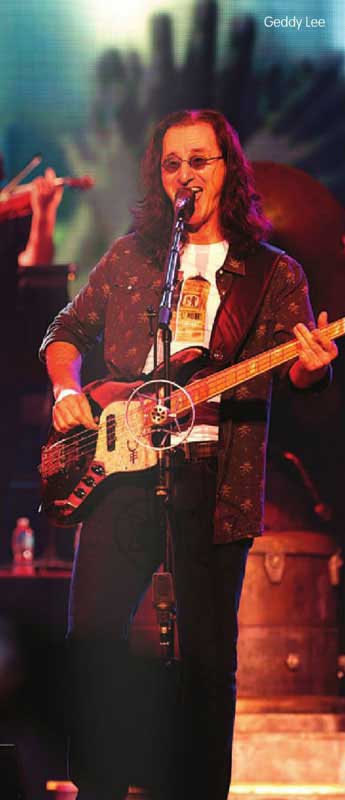
Fixtures
48 Robin 600 LED Washes
S5 Cloy Poky Sharpys
24 High End Systems Intellaspots
44 Spectrum Color Force 48 LED Strips
24 Martin Atomic 3000 Strobes
24 Marlin Mac 3000 Scrollers
10 Vari-Lite VL3500 Profiles
20 Coemor ACL Fixtures
28 Coemar Infinity Washes
20 PixelLine Maxi Wash Fixtures
6 Lycian M2 2.5k Spot Lights
6 High End Systems Showguns
Control & Distribution
3 Full Boar Consoles
3 Full Boar Extension Wings
2 Creative License Art-Net Boxes
1 300' Ethernet control Snake w/power & xlr
5 48-Way Moving Light Distro/208 V Rocks
4 17" Monitors
Rigging & Hardware
5 Silver Aluminum Curved Pods
4 Silver Aluminum Triangles
4 10-ft. x 20" x 20" Black Utility Truss (sl/sr spots and triangles)
6 10-ft. x 20" Black Utility Truss (grid for Eyebrow Pods)
1 15-ft x 20" Black Circle Truss
2 10-ft x 20" Black Utility Truss (spot lights upstage sr/sl)
6 Black Underhung Spot Chairs
8 10-ft. 12" x 12" Black Utility Truss (black backdrop)
10 8-ft. x 30" x 31" MLT
5 Articulating Hinges
12 RSC Lightlocks
8 8-ft. x 20" x 20" Black Utility Truss (cable bridge)
Motor Pockage
32 Show Distribution 1-ton Vario Hoists
12 Pulleys
32 Show Distribution 1-ton Chain Hoists
Clockwork Angels 2013 Crew
Lighting Design & Direction: Howard Ungerleider
Assistant To Howard Ungerleider: Andy O'Toole
Lighting Crew Chief: Martin Joos
Lighting Techs: Josh Rahalski & Tim Whitehall
Programmer: Tim Grivas
Electrician: Curtis Anthony
Pyrotechnics: John Arrowsmith, Pyrotek Special Effects
Video Director: David Davidian
Automation Director: Sebastien Richard
Production Manager: Craig Blazier
Tour Manager: Liam Birt
Road Manager: Donovan Lundstrum
Sfoge Manager: George Steinert
Lighting Company: Premier Global Productions
Additional Lighting: Production Design International
Lighting Reps: Troy Vollhoffer, Steven "Creech" Anderson
Film Producer: Allan Weinrib
Set/Prop Designer & Film Director: Dale Heslip
Trucking Company: Egotrips
Staging/Props: Mood Design
Rigging Company: Five Points Production Services
Video Company: Screenworks